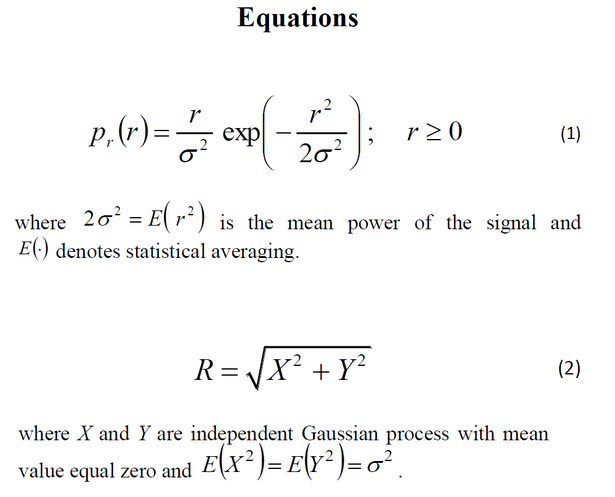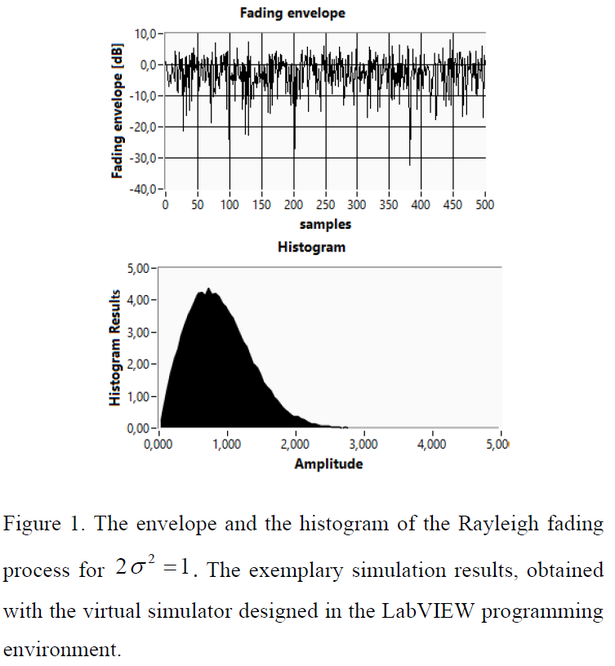Opis
The dataset contains the results of simulations that are part of the research on modelling the multipath fading in the communication channel. The Rayleigh fading envelope is generated using the Monte-Carlo simulation (MCS) in the LabVIEW programming environment.
The Rayleigh probability density function is used as a model for short scale fading in a radio channel. The statistics of the received signal in a mobile radio environment is obtained using the scattering model and the assumption of a large number of randomly phased components. The scattering model describes the local statistics of the received signal envelope. The generation of the Rayleigh fading envelope follows from the basic fact, that the envelope of a Gaussian process with independent quadrature and in-phase components, with the mean equal to zero, has a Rayleigh distribution. The probability density function of the Rayleigh envelope is given by Equation (1).
The Rayleigh envelope can be also written down as a function of the in-phase and quadrature components that specifying the model applied in MCS (Equations 2).
The MCS provides a general approach to numerically approximating the distribution function for the value of the output quantity R(t) = f(X) (where R(t) is a single (scalar) output quantity. X represents the N input quantities (X1(t), . . . ,XN(t))T .
The inputs to the Monte Carlo simulation procedure are:
- the model R(t) = f(X),
- the probability density functions for input quantities X1(t), . . . ,XN (t),
- the number M of Monte Carlo trials.
The probability density functions for X=X1(t) Y=X2(t) are a Gaussian type. The number of Monte Carlo trials is equal to 100 000. The exemplary simulation results, obtained with the virtual simulator designed in the LabVIEW programming environment are shown in Fig. 1.
The simulations were carried out for different values of variance of the Rayleigh distribution.
The attached files contain two columns related to a fading envelope: the number of samples and the amplitude of the fading envelope in [dB] and two columns related to the histogram: the number of bins and the histogram results in percents of total amplitude. Files can be opened in both the LabVIEW software and Windows Office Notepad.
The files are described as follows: MCS_Rayleigh_value of the variance.


Plik z danymi badawczymi
hexmd5(md5(part1)+md5(part2)+...)-{parts_count} gdzie pojedyncza część pliku jest wielkości 512 MBPrzykładowy skrypt do wyliczenia:
https://github.com/antespi/s3md5
Informacje szczegółowe o pliku
- Licencja:
-
otwiera się w nowej karcie
CC BY-NCUżycie niekomercyjne
Informacje szczegółowe
- Rok publikacji:
- 2021
- Data zatwierdzenia:
- 2021-05-31
- Data wytworzenia:
- 2021
- Język danych badawczych:
- angielski
- Dyscypliny:
-
- informatyka techniczna i telekomunikacja (Dziedzina nauk inżynieryjno-technicznych)
- DOI:
- Identyfikator DOI 10.34808/2m4t-zd14 otwiera się w nowej karcie
- Seria:
- Weryfikacja:
- Politechnika Gdańska
Słowa kluczowe
- multipath fading
- communication channel
- Monte-Carlo simulation
- small scale fading
- Rayleigh distribution
Powiązane zasoby
- dane badawcze The Suzuki model of the multipath fading channel
- dane badawcze The generalized Suzuki model of the multipath fading channel
- dane badawcze The Weibull model of the multipath fading channel
- dane badawcze The α-µ model of the multipath fading channel
- dane badawcze The lognormal model of the multipath fading channel
Cytuj jako
Autorzy
wyświetlono 1972 razy

